
Fountain Pen Art: How to Draw With Fountain Pens (+Examples)
(MENAFN- USA Art News) Fountain pen art is art made with a fountain pen and features sketches, drawings, and calligraphy among others. As an artist, working with fountain pens offers incredible value and benefits, especially when you invest in the right pen at authorized fountain pen shops (our favorite being Goldspot Pens !)
Fountain pens are designed to come with ink converters giving you the advantage of working with a variety of ink colors. This is because with these pens you can use your desired inks to refill once they run out.
The flexibility of fountain pens opens up a whole new world of possibilities for you as an artist. If you'd like to learn more about fountain pen art, this post is for you.
Types of Fountain Pen ArtFountain pens are incredible tools that artists have for years continued to take advantage of. These pens are used in creating a variety of art pieces that feature different unique designs and styles.
When working on fountain pen arts, the results will vary depending on the fountain pen nibs and the type of ink you use. When it comes to the fountain pen inks, you have the option of working with different colors or investing in waterproof inks.
Working with waterproof inks will allow you to diversify your art and add some watercolor paints. On the other hand, the fountain nibs you use also influence the outcome of your fountain pen art significantly.
There are different types of nibs that can be used to draw including flex nibs and Fude nibs. The result of your drawing will highly depend on the pressure applied or the technique featured when holding the pen. Here are some of the different fountain pen arts you can achieve.
Fountain Pen DrawingDrawing with a fountain pen that can offer consistent and uniform lines will result in a presentable art piece. When working on fountain pen drawings, keep in mind that you need to vary the line widths to better enhance the look and feel. This will help avoid working on a piece that turns out flat and does not draw anyone's attention.
With fountain pen drawings, you have different nib sizes to work with including extra-fine, fine, medium, and bold. The fountain pen and nib you choose to use is a personal preference. However, ensure that your fountain pen comes with an ink converter to allow you to use bottled ink with ease.
Watercolor Paint and Fountain PensWatercolor paint and fountain pens are two mediums that go well together and can be used to create incredible art pieces. For this, you'd need to invest in the right ink and watercolor paints to ensure that your art pieces turn out well.
When it comes to watercolor paints, as a beginner, working with sets that feature well-curated colors will prove to be the best option. However, with pros who have been in the game for a while, using the paints that come in tubes will allow you to experiment with mixing more colors.
When it comes to the ink, ensure that you invest in waterproof ink or pigmented ink to avoid smudging after adding your watercolor. Watercolor paints and fountain pens are art mediums that will result in unique fountain pen art and allow you to develop your skills further.
Flex Nib Fountain Pen DrawingAs the name suggests, flex nib fountain pen drawings are made using fountain pens that feature flex nibs. These drawings rely heavily on the amount of pressure applied to the fountain pen when creating the art pieces.
This is mainly because flex nibs have the potential of creating different lie thicknesses depending on the pressure applied. If you want to achieve thinner lines, all you'd have to do is relieve the pressure applied.
On the other hand, with thicker lines, building up the pressure will result in the perfect thickness for your art pieces. With this in mind, investing in the right flex nib fountain pens is important to ensure that your experience is pleasant.
Fude Nib Fountain Pen SketchingFude nib fountain pen sketches are made using fountain pens that feature a bent nib which is referred to as the Fude nib. Fude nibs are quite popular among artists who work with Asian calligraphy.
When creating these sketches, what matters most is how you hold the pen. The position of your arms will change quite often to help you achieve different line thicknesses on your art piece. There are different fountain pen brands like Duke and Hero that offer affordable Fude nib pen options for you to experiment with.
What is the Best Fountain Pen For DrawingWhen looking for the best fountain pen for drawing a few factors will come into play that will determine which one works best for you. Keep in mind that different types of fountain pen arts will employ the use of different pens.
These pens include flex nib pens and Fude nib pens. As you figure out the best fountain pen for you to work with, consider the technique used to get the best from the pen you are using.
This will help you determine whether you'd rather work with a pen that features consistent lines, variation of pressure applied, or a variation in how you hold the pen. Here are a few beginner-friendly fountain pens for you to consider working with.
Pilot MetropolitanThe Pilot Metropolitan brand is a great choice when looking to invest in quality fountain pens for drawing. The company boasts over 100 years of experience in the manufacture of fountain pens which guarantees the quality they offer.
The pens are designed to feature a beautiful outer casing with a matte finish and comes in 3 unique colors. They feature 2 nib sizes including fine and medium. This is a great fountain pen to look into especially as a beginner.
Lamy SafariWhen it comes to exploring color and working with incredible fountain pens, Lamy Safari is the perfect choice for you. They feature an incredibly well-designed outer casing that comes in a variety of colors for you to choose from.
These pens also feature a handy window that lets you see the ink converter to help you determine whether to refill your ink. The pens also come with a variety of nib choices from extra fine to bold. This makes them a great fountain pen choice to work with.
Pelikan Pens
Pelikan pens are expert pens that are designed to offer great service and lean more towards the luxury side. The pens feature a sturdy build that lends to their performance and also comes with different nib options. They are a great option when drawing or sketching and will offer a variety of line thicknesses depending on how you use them.
- Fountain Pen Sketches (Examples)
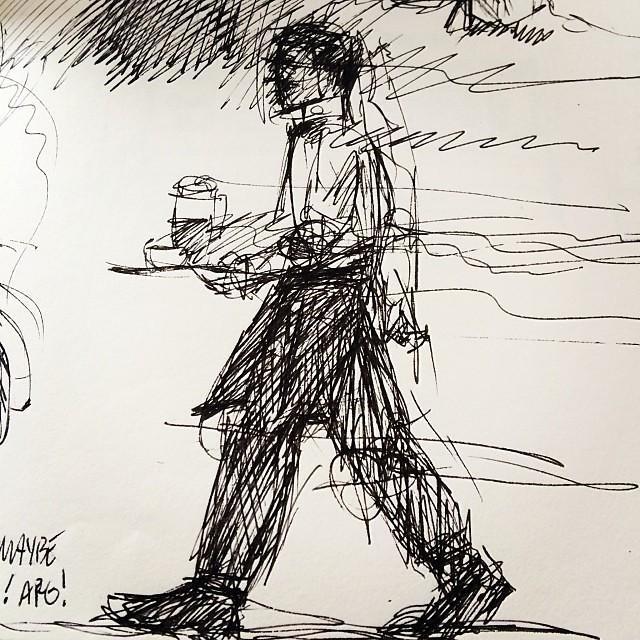
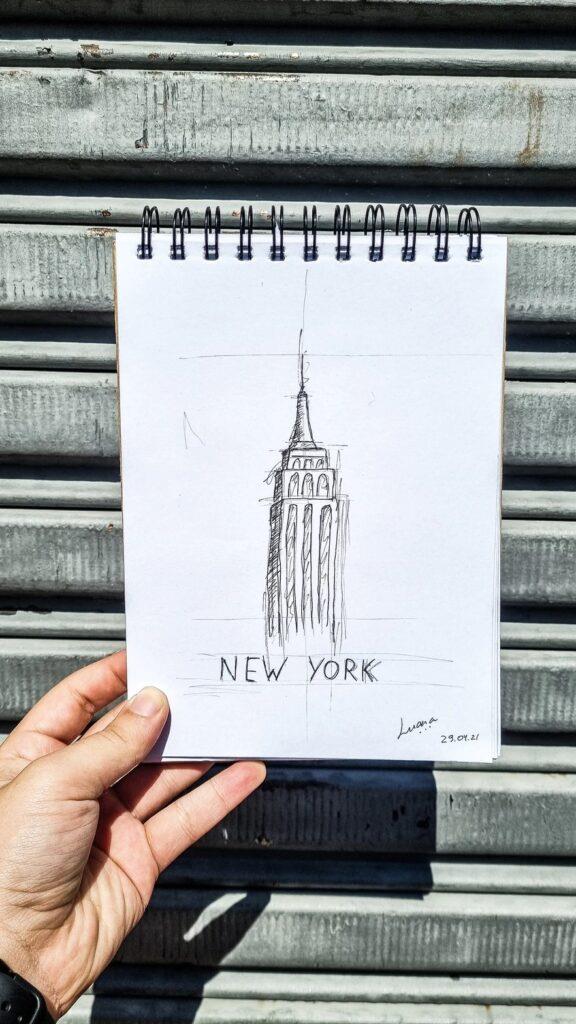
Fountain Pen Calligraphy
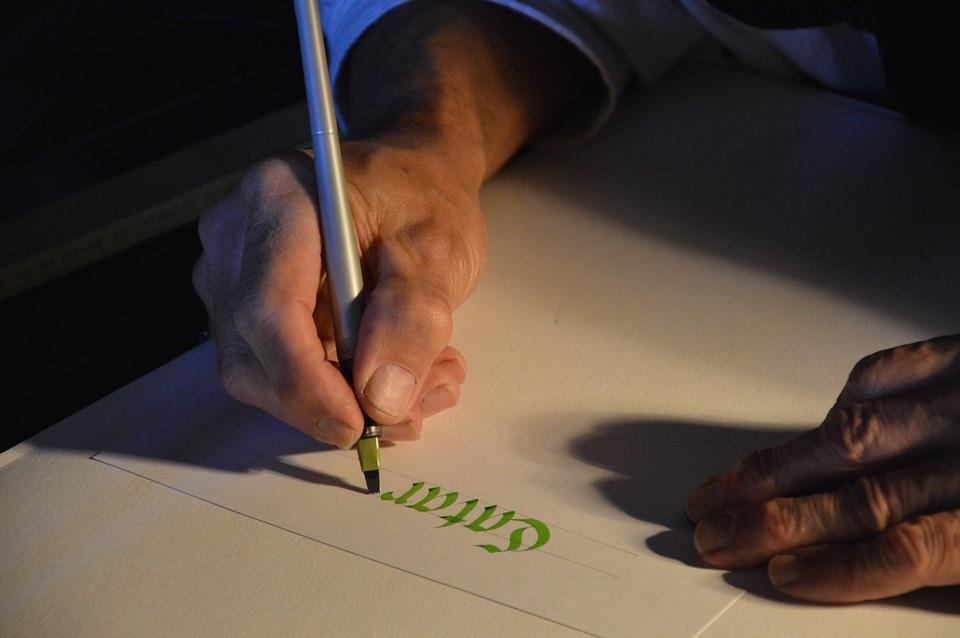
Fountain Pen Mixed Media
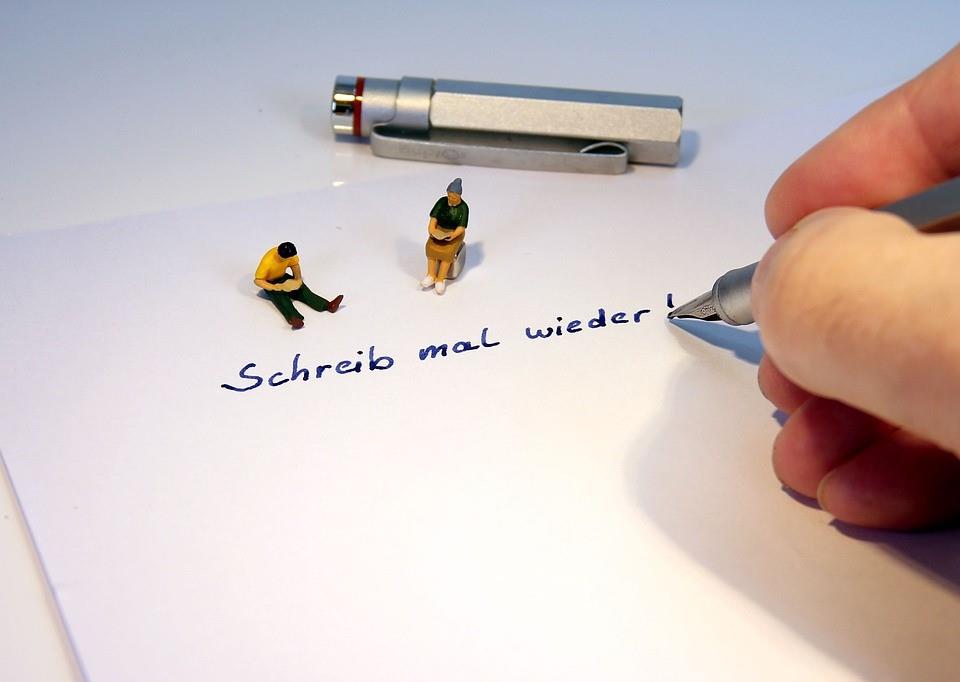
Watercolor and Ink Examples
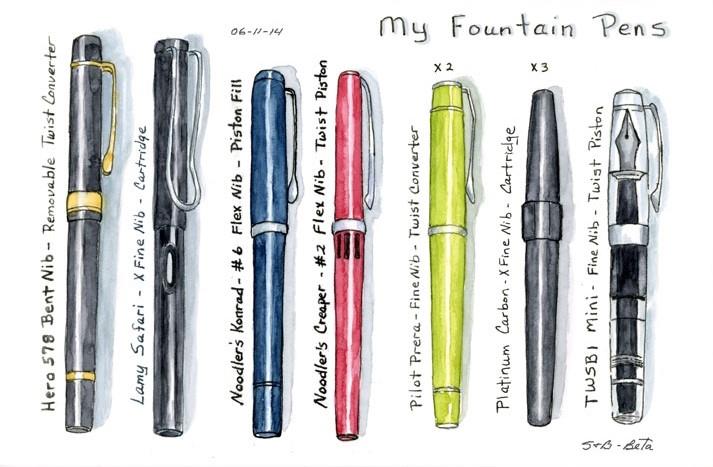
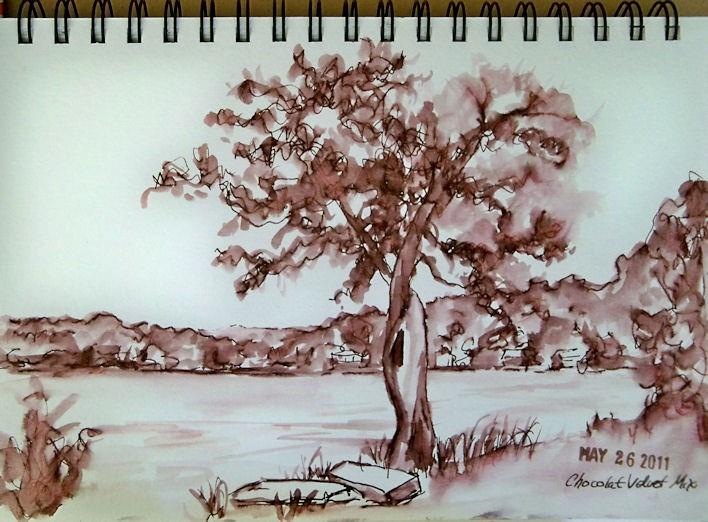
How to Hold a Fountain Pen
When drawing with a fountain pen , the technique used to hold the pen will differ greatly compared to when using a ballpoint pen. A ballpoint pen would be best used in a vertical hold to give you more flexibility.
However, when using a fountain pen, the best way to hold it for maximum results is at a 45-degree angle. This will allow you to loosely hold the pen and get in more movements in your drawing. Holding your pen at this angle will result in quick marks that will enhance the look and feel of your drawing.
How to Draw With Fountain Pens (Drawing Technique)When drawing with fountain pens, there are different techniques that you can employ to help you create the best art piece. These techniques offer a baseline for you to avoid messing up your drawings with unwanted smudges and too much ink on paper. Some of these techniques include:
Shadow Creation TechniquesCreating shadows with your fountain pens can be a bit tricky and may require you to use specific techniques to guarantee success. Some of the best techniques to use when working on this include the stippling technique, hatching, and cross-hatching.
Stippling TechniqueThis is where you create tiny dots on your paper using the fine tip point of your fountain pen. These dots are created to give the illusion of shadows on your art piece. The most important thing to remember here is that the closer your dots are, the darker the shadows you'll be working with.
Hatching and Cross-hatching TechniqueThese techniques are a great option when looking to add shadows to your ink work. They involve drawing lines that are placed close together resulting in a shadow effect. These two techniques are quite similar in their applications and the results they offer.
The major differences are that the hatching technique features lines that go in one direction while cross-hatching features lines that cross over each other forming an 'X'. When deciding which technique to use, you need to consider your end results.
Keep in mind that hatching is best used when looking to create a neat fountain pen art while cross-hatching will be better used when looking to create a messy art piece.
Mark Making TechniquesWhen making different marks with your fountain pen, the best technique to apply is always bringing it towards you. This will help you prevent having too much ink on your paper that may ruin your drawing.
Additionally, the pressure you apply to your fountain pen is important. It will determine the thickness of your lines.
As we discussed earlier, varying the pressure you apply on your fountain pen will allow you to easily create different line widths. Using this technique will allow you to use the same pen to create a drawing that has different distinguishing features.
Understanding Line Variation with Fountain Pen ArtLine variations are a must-have when working on your fountain pen art. Without them, you risk creating an art piece that is flat and does not capture people's interest. However, with line variations, you can create more depth and add texture to your fountain pen art.
Fountain pens make it quite easy to work with line variations given that all you need to do is control the pressure you apply on your fountain pen. Different fountain pen types will result in different line variations which make for interesting drawings and sketches.
Understanding line variations will require you to incorporate more hatching and cross-hatching techniques to create desired shadows. Additionally, you can utilize the line variations by using thicker lines on the characters in the foreground and thinner lines on characters and objects in the background. This is a great way to make line variations work for you and add more texture and style to your drawings.

Legal Disclaimer:
MENAFN provides the
information “as is” without warranty of any kind. We do not accept
any responsibility or liability for the accuracy, content, images,
videos, licenses, completeness, legality, or reliability of the information
contained in this article. If you have any complaints or copyright
issues related to this article, kindly contact the provider above.

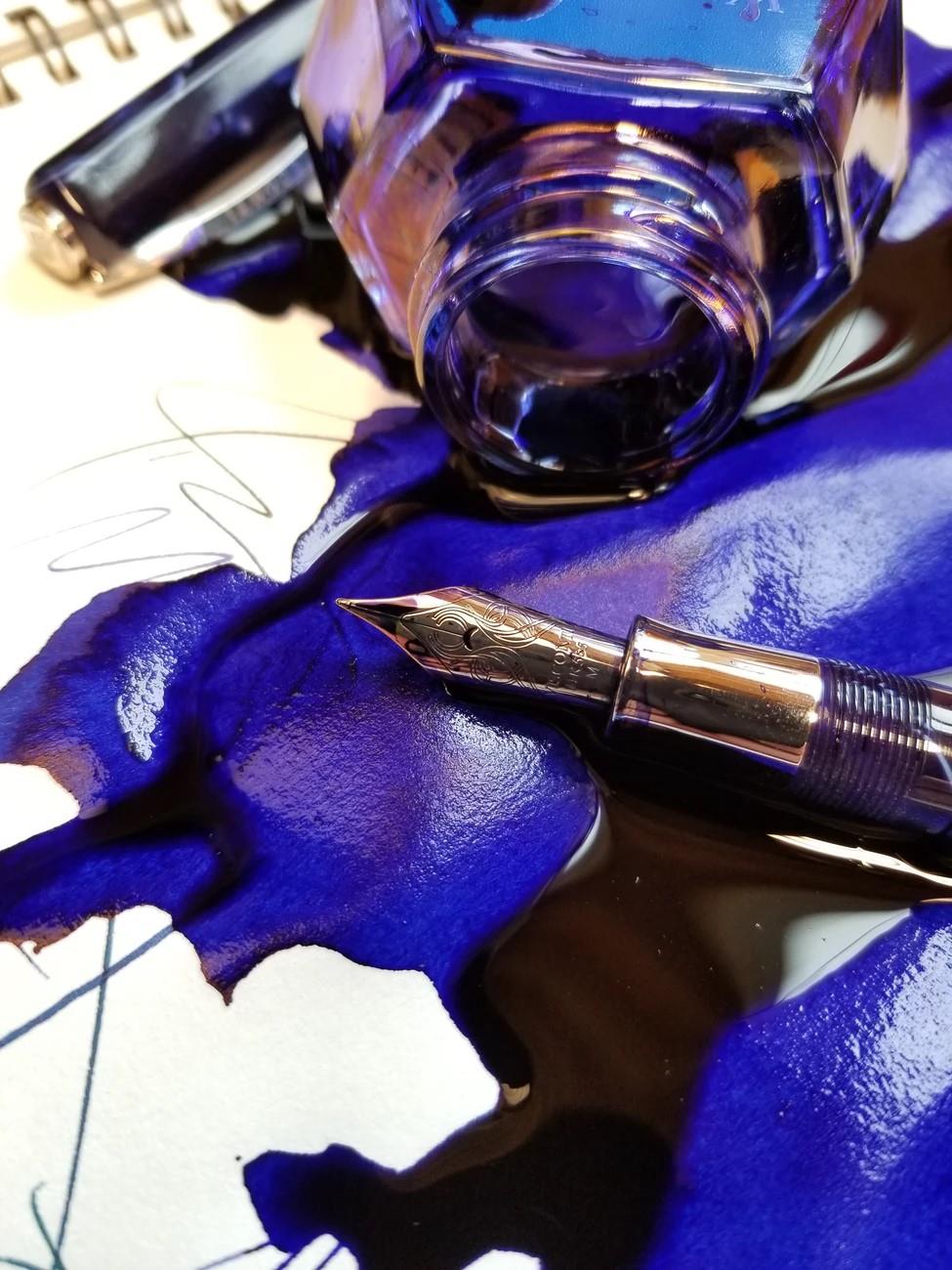
















Comments
No comment